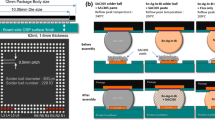Abstract
The high thermal conductivity and light weight properties of aluminum (Al) make it a promising material in high power device packaging and automotive electronics. A primary challenge is its high coefficient of thermal expansion (CTE) of 23 ppm/°C. In this research, we investigated the possibility of surmounting this challenge by bonding large Si chips to Al substrates using fluxless tin (Sn) solder. The Si–Al pair probably has the largest CTE mismatch among all bonded structures in electronic packaging. In experiments, 0.1 μm Cr layer and 0.2 μm Cu layer were deposited on Al substrates, followed by an electroplated 25 μm copper (Cu) layer. The Sn solder layer was then electroplated over the Cu, followed immediately by thin (0.1 μm) silver (Ag) layer. The joint thickness was controlled either by bonding pressure or by incorporating Cu spacers. Microstructure and composition of the joints were studied with scanning electron microscopy and energy dispersive X-ray spectroscopy. Despite the large CTE mismatch, the bonded structures did not break. The minimum fracture force measured among six samples by shear test is higher than three times of what specified in MIL-STD-883H, method 2019.8. This preliminary result corroborates potential adaption of Al substrates and boards in electronic packaging where lightweight is essential.









Similar content being viewed by others
References
S. Lee, Optimum design and selection of heat sinks. IEEE Trans. Compon. Packag. Manuf. Technol. Part A 18, 812–817 (1995)
C. Zweben, Advances in LED packaging and thermal management materials. Proc. SPIE Int. Soc. Opt. Eng. 6910, 691018 (2008)
P.-M. Geffroy, J.-D. Mathias, J.-F. Silvain, J.-F. Silvain, Heat sink material selection in electronic devices by computational approach. Adv. Eng. Mater. 10, 400–405 (2008)
M.A. Gaynes, H. Shaukatullah, in Evaluation of Thermally Conductive Adhesives for Bonding Heat Sinks to Electronic Packages. 1993 43rd IEEE Electronic Components & Technology Conference (1993), pp. 765–771
S.K. Kang, S. Purushothaman, Development of conducting adhesive materials for microelectronic applications. J. Electron. Mater. 28, 1314–1318 (1999)
O. Kueckmann, Light-Emiting Diodes: Research, Manufacturing, and Applications X, High Power Led Arrays—Special Requirements on Packaging Technology—Art. No. 613404 (2006)
P.J. Wang, J.S. Kim, D. Kim, C.C. Lee, Fluxless bonding of silicon wafers to molybdenum substrates using electroplated tin-rich solder. J. Mater. Sci.: Mater. Electron. 20, 334–342 (2009)
W.P. Lin, D.E. Wesolowski, C.C. Lee, Barrier/bonding layers on bismuth telluride (Bi2Te3) for high temperature thermoelectric modules. J. Mater. Sci.: Mater. Electron. 22, 1313–1320 (2011)
S.J. Hsu, C.C. Lee, Fluxless tin bonding of silicon chips to iron substrates. J. Mater. Sci.: Mater. Electron. 24, 2890–2896 (2013)
K.L. Lin, S.Y. Chang, The morphologies and the chemical states of the multiple zincating deposits on Al pads of Si chips. Thin Solid Films 288, 36–40 (1996)
K. Azumi, T. Yugiri, M. Seo, S. Fujimoto, Double zincate pretreatment of sputter-deposited Al films. J. Electrochem. Soc. 148, C433–C438 (2001)
M.K.M. Arshad, I. Ahmad, A. Jalar, G. Omar, U. Hashim, The effects of multiple zincation process on aluminum bond pad surface for electroless nickel immersion gold deposition. J. Electron. Packag. 128, 246–250 (2006)
K.J. Zeng, R. Stierman, T.C. Chiu, D. Edwards, K. Ano, K.N. Tu, Kirkendall void formation in eutectic SnPb solder joints on bare Cu and its effect on joint reliability. J. Appl. Phys. 97, 024508 (2005)
J.O. Suh, K.N. Tu, N. Tamura, Preferred orientation relationship between Cu6Sn5 scallop-type grains and Cu substrate in reactions between molten Sn-based solders and Cu. J. Appl. Phys. 102, 063511 (2007)
J.O. Suh, K.N. Tu, G.V. Lutsenko, A.M. Gusak, Size distribution and morphology of Cu6Sn5 scallops in wetting reaction between molten solder and copper. Acta Mater. 56, 1075–1083 (2008)
Y.-W. Yen, W.-T. Chou, Y. Tseng, C. Lee, C.-L. Hsu, Investigation of dissolution behavior of metallic substrates and intermetallic compound in molten lead-free solders. J. Electron. Mater. 37, 73–83 (2008)
P.M. Hall, Creep and stress relaxation in solder joints, in Solder Joint Reliability Theory and Applications, ed. by J.H. Lau (Van Nostrand, New York, 1991), pp. 307–330
Author information
Authors and Affiliations
Corresponding author
Rights and permissions
About this article
Cite this article
Hsu, SJ., Sha, CH. & Lee, C.C. Fluxless bonding of Si chips to aluminum boards using electroplated Sn solder. J Mater Sci: Mater Electron 25, 3276–3284 (2014). https://doi.org/10.1007/s10854-014-2014-z
Received:
Accepted:
Published:
Issue Date:
DOI: https://doi.org/10.1007/s10854-014-2014-z




